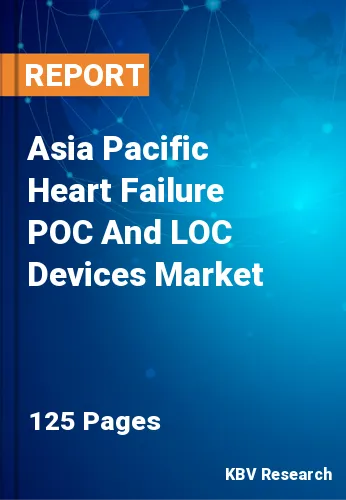The Asia Pacific Heart Failure POC And LOC Devices Market would witness market growth of 17.3% CAGR during the forecast period (2023-2030).
Point-of-care (POC) devices refer to medical diagnostic tools designed near the patient, allowing for real-time testing and immediate clinical decision-making. On the other hand, lab-on-a-chip (LOC) devices are miniature laboratories integrated into a small chip, enabling the analysis of biological samples with minimal reagents and in a rapid manner. These devices transform traditional healthcare delivery, offering portability, cost-effectiveness, and quicker results than conventional laboratory methods.
Due to its miniaturization, lab-on-a-chip (LOC) technology can significantly enhance disease diagnosis in terms of cost-effectiveness, throughput, simplicity of operation, and analysis. Innovative LOC-based assays for the diagnosis of cardiovascular disease (CVD) are anticipated to be the focus of market-driving R&D. The implementation of lab-on-a-chip (LOC) technology has facilitated central lab testing and point-of-care (POC) diagnostics. Currently, however, only proof-of-concept (POC) tests are commercially available for diagnosing cardiac failure. Subsequently, this has generated profitable prospects for nascent diagnostic developers endeavoring to establish a significant foothold in this industry.
The aging population in many countries in the Asia Pacific is a vital driver of the rising prevalence of heart failure. According to Invest India, the telemedicine industry is India's maximum potential eHealth segment, which is expected to reach $5.4 Bn by 2025. China is experiencing a substantial demographic shift with an increasingly aging population. Age-related risk factors such as hypertension, diabetes, and other cardiovascular risk factors are prevalent among the elderly in China. POC and LOC devices enable timely monitoring of these risk factors, contributing to the prevention and early intervention in heart failure cases. Due to the aforementioned factors the market will drive in this region.
The China market dominated the Asia Pacific Heart Failure POC And LOC Devices Market by Country in 2022 and would continue to be a dominant market till 2030; thereby, achieving a market value of $18,693.3 Thousands by 2030. The Japan market is registering a CAGR of 16.6% during (2023 - 2030). Additionally, The India market would showcase a CAGR of 18.1% during (2023 - 2030).
Based on Test Type, the market is segmented into Proteomic Testing, Metabolomic Testing, and Genomic Testing. Based on End Use, the market is segmented into Clinics, Hospitals, Laboratory, Assisted Living Healthcare Facilities, and Home. Based on Technology, the market is segmented into Microfluidics, Array-Based Systems, and Others. Based on countries, the market is segmented into China, Japan, India, South Korea, Singapore, Malaysia, and Rest of Asia Pacific.
Free Valuable Insights: The Global Heart Failure POC And LOC Devices Market is Predict to reach $252.9 Million by 2030, at a CAGR of 16.4%
The market research report covers the analysis of key stake holders of the market. Key companies profiled in the report include Abbott Laboratories, Siemens Healthineers AG (Siemens AG), Danaher Corporation, F. Hoffmann-La Roche Ltd., BioMerieux S.A., QuidelOrtho Corporation, Trinity Biotech Plc, Jant Pharmacal Corporation, Abaxis, Inc. (Zoetis Services LLC) and Werfen, S.A.
By Test Type
By End Use
By Technology
By Country
Our team of dedicated experts can provide you with attractive expansion opportunities for your business.

